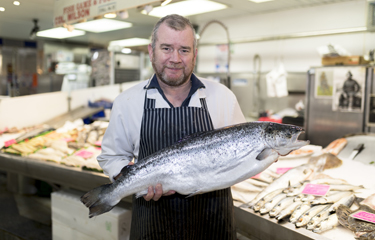Chilled fish sales in U.K. grocery stores continued to decline in the most recent quarter, dampened by higher overall grocery prices.
Overall U.K. chilled fish sales dropped 8 percent year-on-year to GBP 493.3 million (USD 592 million, EUR 579 million) for the quarter ending 12 June, according to research firm Kantar.
The sub-categories with the biggest sales drops included battered (down 17.5 percent), breaded (down 16.6 percent), and smoked (down 12.1 percent). As a result, the greatest volume declines for the quarter were in battered seafood (down 18.3 percent), breaded seafood (down 18 percent), and smoked fish (down 14.9 percent).
“This fall in volume compared to the relatively better volume performance of chicken suggests that some shoppers maybe trading out of relatively more-expensive added-value products and [moving] into cheaper proteins that can stretch further,” Kantar said in its Meat, Poultry and Fish Market Update.
The overall volume in the meat, fish and poultry category is down 18 percent versus two years ago, “with value performance better on the back of strong inflation,” Kantar noted.
Like-for-like grocery price inflation reached 9.9 percent for the month ending 12 June, rising 1.6 percentage points from the previous month. It is the second-highest level of grocery inflation that Kantar has seen since it started tracking prices in 2008, Kantar Head of Retail and Consumer Insight Fraser McKevitt said in a press release.
“And we’re likely to surpass the previous high come August,” McKevitt said.
Inflation has had a dampening effect on seafood sales in the U.K. thus far in 2022, but overall, seafood prices have remained consistent since inflationary pressures have started to impact the wider grocery and protein market, Kantar Category Analyst Kell Davies told SeafoodSource.
“Seafood has the fourth-lowest inflation rate of 1.3 percent versus the main protein categories,” Davies said, referring to the most-recent quarter as compared to the same quarter of 2021. In contrast, chicken prices increased 11.5 percent over the same time period, and beef prices rose 7 percent.
Despite the inflationary trend, overall U.K. grocery sales rose 0.1 percent in the quarter, the first time sector sales have grown since April 2021, according to Kantar. Sales of products such as sun care and ice cream due to the extreme heat wave hitting Europe fueled overall increased sales.
Still, rising prices are leading to a change in shopping behavior.
“People are increasingly turning to own-label products to drive down the cost of their weekly shop,” McKevitt said.
Supermarkets’ own lines are growing by 4.1 percent, while sales of branded items dropped 2.4 percent.
“It’s a complex picture and the grocers are busy negotiating with their suppliers to mitigate impact at the tills as far as possible,” he said. “We’ve seen this play out in the headlines in recent weeks, with some well-known brands temporarily disappearing from supermarket shelves over pricing disputes.”
Britons are also shopping more in discount stores. Lidl was the fastest-growing supermarket again this quarter, sporting a 13.9 percent increase in sales, and Aldi’s sales soared by 11.3 percent.
“Over 67 percent of people in Britain shopped in either an Aldi or a Lidl in the past 12 weeks, with 1.4 million additional households visiting at least one of the discounters in the latest three months compared with last year. Both retailers reached a new market share high over the past three months,” McKevitt said.
Lidl now holds a 7 percent share of the market and Aldi climbed to a 9.1 percent share.
Tesco reported its first quarterly growth since October, with an increase of sales of 0.1 percent and a market share of 27.1 percent. Ocado was the only other retailer reporting growth, holding its market share steady at 1.8 percent while its sales rose 0.7 percent.
Sainsbury’s holds a 14.9 percent share of the market, followed by Asda at 13.7 percent and Morrisons 9.4 percent.
Photo courtesy of F-Stop boy/Shutterstock







